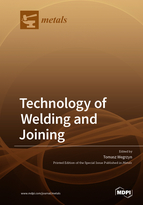Technology of Welding and Joining
A special issue of Metals (ISSN 2075-4701). This special issue belongs to the section "Welding and Joining".
Deadline for manuscript submissions: closed (1 February 2021) | Viewed by 34737
Special Issue Editor
Interests: welding; joining; brazing; soldering; cutting; overlay welding; surfacing; cladding; thermal spraying; resistance welding; solid state welding; welding with micro-jet cooling
Special Issues, Collections and Topics in MDPI journals
Special Issue Information
Dear Colleagues,
Welding technology is constantly improving. New welding processes and welding methods are emerging. For example, the use of micro-jet cooling in the welding of various grades of steel and aluminum alloys has recently been observed. New welding processes allow the structure of the joint to be controlled and thus have an impact on the material properties. New types of materials are emerging for which the most appropriate welding technologies have not yet been developed. With a view to new welding products, we offer this Special Issue entitled "Technology of Welding and Joining". The purpose of this Special Issue is to organize information about new construction materials and the possibility of their correct welding, taking into account existing welding technologies and new ones.
Prof. Dr. Tomasz Węgrzyn
Guest Editor
Manuscript Submission Information
Manuscripts should be submitted online at www.mdpi.com by registering and logging in to this website. Once you are registered, click here to go to the submission form. Manuscripts can be submitted until the deadline. All submissions that pass pre-check are peer-reviewed. Accepted papers will be published continuously in the journal (as soon as accepted) and will be listed together on the special issue website. Research articles, review articles as well as short communications are invited. For planned papers, a title and short abstract (about 100 words) can be sent to the Editorial Office for announcement on this website.
Submitted manuscripts should not have been published previously, nor be under consideration for publication elsewhere (except conference proceedings papers). All manuscripts are thoroughly refereed through a single-blind peer-review process. A guide for authors and other relevant information for submission of manuscripts is available on the Instructions for Authors page. Metals is an international peer-reviewed open access monthly journal published by MDPI.
Please visit the Instructions for Authors page before submitting a manuscript. The Article Processing Charge (APC) for publication in this open access journal is 2600 CHF (Swiss Francs). Submitted papers should be well formatted and use good English. Authors may use MDPI's English editing service prior to publication or during author revisions.
Keywords
- welding
- joining
- brazing
- soldering
- cutting
- overlay welding
- surfacing
- cladding
- thermal spraying
- resistance welding
- solid state welding
- welding with micro-jet cooling






